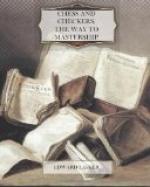In the position of Diagram 83 Black threatens to queen either of his Pawns. White can play (1) Kt-e3+ K-e2; (2) Bxh2, but after Kxe3 there seems to be no way of stopping the Pawn f2.
+---------------------------------------+ 8 | #K | #B | | ^Q | | | | | |---------------------------------------| 7 | | #P | | | | | | | |---------------------------------------| 6 | #P | ^P | | | | | | | |---------------------------------------| 5 | ^P | | ^Kt| | | | | | |---------------------------------------| 4 | | ^P | | ^Kt| | | | | |---------------------------------------| 3 | | | | | #K | | | | |---------------------------------------| 2 | | | | | | | | | |---------------------------------------| 1 | | | | | | | | | +---------------------------------------+ a b c d e f g h
Diagram 84.—Sui-Mate in Six Moves
Again an ingenious trick is available which leads to an unexpected finish. White plays (3) K-h8 threatening to Queen his Pawn and forcing B-d5. Then he gives up his Pawn by (4) P-g8 (Queen) and after Bxg8 he saves the game by (5) B-g1 !! If Black takes the Bishop promoting the Pawn to a Queen or a Rook White is stalemate. Otherwise the draw is forced by either Kxg8 or Bxf2.
It remains to explain the meaning of the so- called sui-mates. A sui-mate is a problem in which White has to play so as to force Black to checkmate him (White) in a certain number of moves. One of the most beautiful examples in the literature is the above six mover, the solution of which runs as follows: (1) Kt-b5, Pxb5; (2) Kt-a6, Pxa6. One should not think that White can force Black to checkmate in four more moves; but: (3) K-d4, K-b7; (4) Q-d5+, K-c8; (5) P-b7+, K-c7; (6) K-c5 and Black has no other move except B-a7, checkmating White.
PART II
THE GAME OF CHECKERS
I
THE RULES OF THE GAME
The game of Checkers (English: Draughts) is played on the 32 black or white squares of the Chess board by two opponents, each of whom has twelve men of the same kind. The object of the game is to capture all opposing men or to block them so that they cannot move.
The original position of board and men is shown in Diagram 85. It will be seen that the board is placed in such a way that the players have a vacant square at their lower right hand corner. This corner is called the double corner because two men are located in its immediate neighborhood while the left hand corner, the single corner, is occupied by only one man.
The squares of the Checker board are usually described by numbers as shown in Diagram 86. This is a rather crude method when compared with the simple notation by means of a system of coordinates as used in Chess, but as it is universally employed in Checker books and Checker columns in daily papers it will be adhered to in the following explanation of the game.




